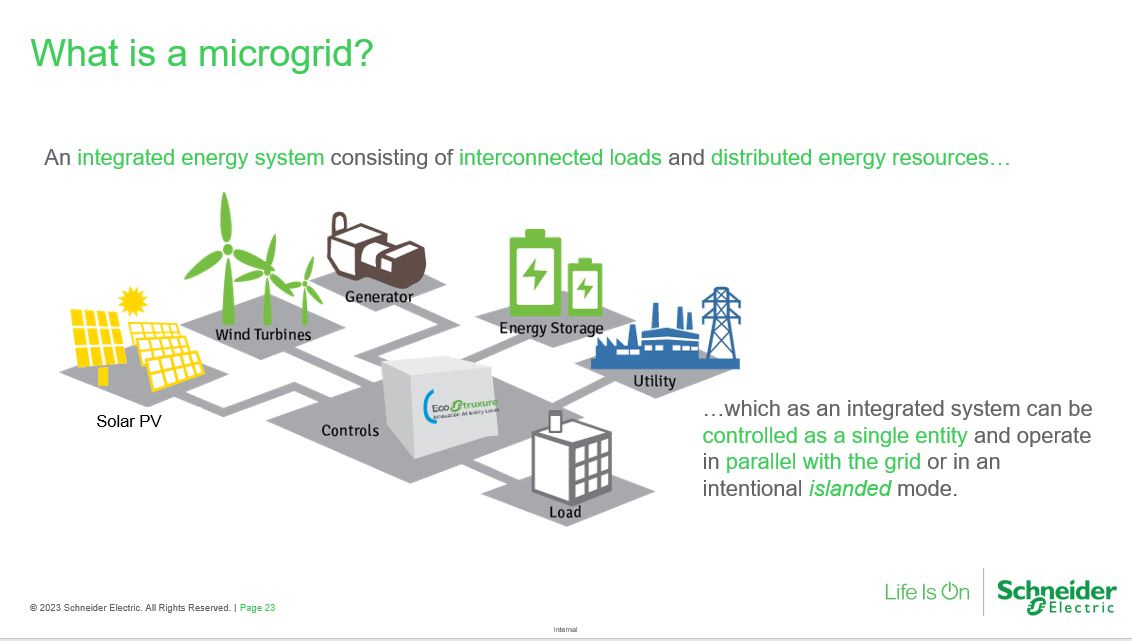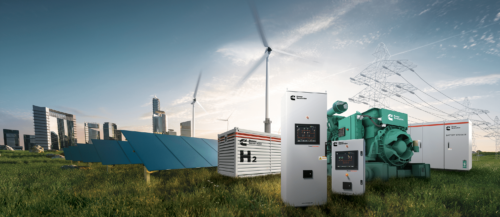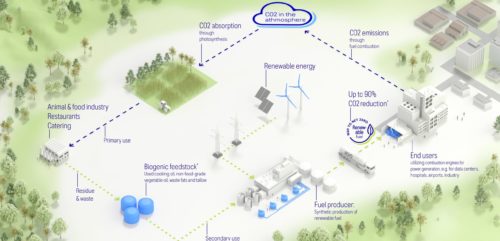Your questions answered: What is the new energy landscape and how does it affect microgrids?
By designing a microgrid for a building or campus, engineers can help their clients reduce reliance on the electric utility. Read this Q&A for extra information
Microgrid insights
- A microgrid is a small network of electricity users with a local source of supply that is usually attached to a centralized national grid, but can function independently.
- Electrical engineers are often tasked with designing a microgrid for building or campus clients.
While relatively consistent for close to 100 years, the electric utility grid and the building market it supplies is now forced to change. Users of energy are increasingly also becoming producers and thus “prosumers.” This backdrop, along with the drive for digital transformation, sustainability and resilience is driving a “new energy landscape.” Microgrids are a way to optimize this scenario while also optimizing energy costs.
Review these additional responses from Gregg Morasca, VP, Microgrid Content, North America Operations, Schneider Electric, which were answered after the “What is the new energy landscape and how does it affect microgrids?” webcast Aug. 10, 2023.
Question: Where are some cost-effective energy storage options in modern microgrid systems?
Answer: Lithium-ion batteries are the lowest cost option compared to other battery technologies. This is based on upfront cost and the lifetime of the system. The next option for cost effective energy storage is lead acid batteries. Please refer to the list for top nine most cost-effective energy storage options.
-
Lithium-ion batteries
-
Flow batteries
-
Flywheel energy storage
-
Supercapacitors
-
Hydrogen fuel cells
-
Thermal energy storage
-
Compressed air energy storage
-
Sodium sulfur batteries
-
Advanced lead-acid batteries.
Question: Do you see SMR [nuclear] as viable elements of a microgrid?
Answer: SMRs have the potential to be viable elements of a microgrid in certain circumstances since they are smaller and more flexible and can generate low level of electricity when compared to traditional large scale nuclear reactors. Some factors that make them suitable for integration include reliable baseload power, diverse energy mix, reduced carbon emissions, long operating life, less space and infrastructure requirements. However, some complex challenges revolve around the fact that nuclear power is highly regulated due to safety and security concerns. Making the decision to integrate SMRs would mean seeking compliance with nuclear regulatory requirements which can be time consuming. It is also important to consider that the upfront capital costs of SMRs can be heavy and the financial feasibility of integrating an SMR would depend of different factors such as available funding, project scale and cost-sharing arrangements. Also, it is important to note that that if we integrate SMRs into microgrids then we need proper management of nuclear waste since storage and disposal of nuclear waste requires planning in advance and can pose several challenges.

Courtesy: Consulting-Specifying Engineer, Schneider Electric
Question: You mentioned grid stability during natural disasters from microgrids but, from what my company has been a part of, it is usually infeasible to “island” our renewable project either due to cost or the utility’s mandate. In other words, when the grid does down, so does our project. How have you gotten around this issue such that your projects are resilient during natural disasters?
Answer: Islandable microgrids are designed with what we call an “anchor resource” so that even when there is a power outage, there is an automated system in place that can isolate from the main grid (ex. Open the site’s main circuit breaker) and then turn on a power source that can provide a voltage reference. This anchor resource (source providing a voltage reference) might be a generator or a battery energy storage system (BESS). This type of system is required to submit an interconnection application and clearly define the islanding intent in the application in conjunction with the utility’s requirements.
Question: How are we handling the impact on grid stability caused by the increasing DERs?
Answer: Contrary to the common belief that high penetration rates of DER degrade power quality and reliability, the experience in Germany has shown improved grid reliability over the past 10 years. According to the German regulatory agency, BnetzA, in 2021, “The electricity supply in Germany was again very reliable in 2020… the outage time was lower than in the previous year… As in the past, the energy transition and the growth in distributed generation have not had any negative effects on the quality of supply.” Grid stability is supported through optimization software that leverages automation technologies, including machine learning, artificial intelligence, advanced forecasting and advanced displays. This enables operators to operate their systems for efficiently.
Question: Do these DER’s have the same capabilities of providing zero sequence fault currents as traditional rotating machine generators?
Answer: DERs, including PV systems and BESS, generally do not have the same inherent capability to provide zero sequence fault currents as traditional rotating machine generators. The amount of fault current support that DERs can provide depends on various factors, including their design, control capabilities and the specific requirements of the grid they are connected to. While inverter based DERs might not replicate the same level of zero sequence fault current contribution as traditional rotating generators, they can be engineered to offer some level of fault current support to enhance grid stability.
Question: How receptive are utility companies to the grid-tied approach? I have had them more receptive to island-able and a huge hurdle in proving systems that parallel theirs.
Answer: The receptiveness of utility companies to grid-tied microgrid approaches can vary depending on many factors such as region, utility company policies, regulatory environment and specific goals and benefits that microgrids offer. There are factors such as the stability and reliability of the grid that can have a large impact. Grid-tied microgrids that can integrate with the main grid and provide support during peak demand or emergencies can be seen as beneficial by utilities. Another factor is renewable energy integration. Grid-tied microgrids with renewable energy sources, such as solar and wind, can help utilities meet renewable energy targets. Utility companies interested in transitioning to cleaner energy sources can view grid-tied microgrids positively. Some potential challenges that lead to their resistance include ensuring that microgrid systems are technically compatible with the utility’s existing infrastructure and can operate safely and efficiently in parallel can be a challenge. In addition, meeting grid interconnection standards and requirements set by regulatory bodies and industry organizations can require careful planning and coordination.
Overall, the receptiveness of grid-tied microgrids by utility companies continues to change as the benefits become more apparent and as regulatory frameworks adapt to accommodate these new technologies. It is important to ensure there is communication and allude to the value that grid-tied microgrids can bring to both the utility and the broader energy system.
Question: So to be clear having a microgrid is still connected to the national grid so it is still putting a lot of strain on the national grid which I have read over and over is already maxed out and need to be upgraded which of course is a big cost to the nation. Is this true?
Answer: There are different designs to a microgrid. For instance, in a grid-connected microgrid it does remain connected to the main power grid but it has the option to operate independently if it is necessary. It is also important to keep in mind that during normal operation of the microgrid it takes from the grid but it also gives back to the grid. A grid-connected microgrid can supply power to the area and potentially reduce the demand on the national grid during peak usage periods. In addition, when the microgrid generates excess power, it can either feed it back to the main grid if the utility finds that it can help alleviate some of the strain or microgrids can be designed such that excess generation is curtailed or stored for later use, which we call non-export. These designs must be taken on a case-by-case basis with the utility.
In addition, when the microgrid generates excess power, it can either feed it back to the main grid if the utility finds that it can help alleviate some of the strain or microgrids can be designed such that excess generation is curtailed or stored for later use, which we call non-export. These designs must be taken on a case-by-case basis with the utility.
Question: What would you class net metered facility that co-gens its power?
Answer: Net metering is a way for facilities to receive financial compensation for the on-site power they produce. If there are multiple distributed energy resources operating at the site, such as solar + BESS, then we consider it a grid-connected microgrid.
Question: Frequency matching and harmonic mitigation for dc-ac generating equipment?
Answer: The microgrid assets themselves in conjunction with the appropriate power quality solutions can provide frequency stability and harmonic mitigation. This should be evaluated on a site-by-site basis where power quality issues are prevalent. The loads and sources must be evaluated holistically.
Question: Are there any special codes and regulations we need to consider when designing Microgrids?
Answer: Yes, this is something that is very specific to the state and utility. As part of a feasibility study, we will investigate those rules and regulations in order to build a microgrid for the customer that is compliant with their local and state regulations.
Question: Is it appropriate to call an off-grid microgrid a microgrid and not minigrid if there is no utility?
Answer: Different organizations might use the terms interchangeably. Most often, the minigrid term is used when referencing a fully off grid that no central utility currently serves. It is a good practice to communicate the details clearly to avoid confusion and to ensure that the terminology aligns with industry standards and the understanding of the intended audience.
Question: Which DER’s require the most maintenance requirements?
Answer: A microgrid system should be maintained and tested with regularity as a system. If one DER is underperforming, it may impact the performance of the system. Typical maintenance schedules depend widely on the use case that the DER is performing and the criticality of the site.
Question: Do you have the total energy loss, in percent, from the power generation station, through transmission, distribution and down to charging system and into the EV?
Answer: Typical system losses from central power plants through transmission and distribution are generalized between 8 to 15%. By producing power on-site through the microgrid, these system losses are not incurred.
Question: System needs to include automated fault analysis to identify faults and reconfigure the system, within ms, to maintain frequency of the system.
Answer: Fully agreed. Fault analyses and system coordination are key parts to any microgrid design.
Question: Does Schneider Electric make an EEC?
Answer: EEC or ECC? We have a microgrid technology called an Energy Control Center (ECC) which brings together electrical distribution with the brains of a microgrid (microgrid controller) into a single tested solution. It is a simplified way to bring together hardware and software, to connect DERs into a facility at low voltage (480V). Schneider Electric does not make Energy Efficiency Controllers
Question: Does energy optimization software/analysis include O&M costs? My understanding is that electrical equipment is generally designed for steady-state operation. Switching wears out the equipment faster based on my experience with capital improvement projects performed.
Answer: O&M costs should be projected during system design and take into account the switching and usage of the system components. The microgrid optimization software, “EcoStruxure Microgrid Advisor” does not provide preventative maintenance predictions natively but another software, EcoStruxure Asset Advisor that Schneider has launched does provide preventative maintenance evaluations.
Question: Have you done microgrids in large water/waste water plants?
Answer: We do have experience in WWW segment applications. Because these sites vary significantly in size and complexity, the architecture is often site dependent. The goal is to always maintain the resiliency needed for these critical sites while maximizing the production of the on-site resources during the normal grid connected mode.
Question: On page 47, where you have a diesel generator in parallel with inverter based DERs, how do you allow PV to back up critical loads while still maintaining critical loads in 10s. Or is the whole system protected by UVRs to disconnect DERs when no utility is available.
Answer: When utility is unavailable, the anchor resource, such as a generator in this instance would come online within the normal time frame (perhaps 10s in some applications). Once the stable voltage is detected, the microgrid controller would enable the PV to parallel to the generator and prioritize power stability and operating conditions of the generator while accepting as much renewable production.
Question: 1. Is it recommended to utilize local ac power for motorized breaker control power or have a separate dedicated dc battery system (like how utilities control their breakers)? 2. What is minimal operating speed of breaker operation needed?
Answer: Using ac power over having a dedicated dc battery system for motorized breaker control power depends on different factors such as maintenance, cost and reliability. Both have their advantages, for ac power, it is more reliable in terms of power availability and does not require charging systems and dedicated batteries. However, there are some issues like voltage fluctuation and interruptions in the local ac supply that can impact breaker operation. On the other hand, a separate dc battery system can provide reliable and independent power source for breaker control. For facilities with critical loads like hospitals and data centers might benefit more from a dc battery system to make there is uninterruptible breaker control. In facilities with less critical loads local ac power may be enough and is also the more cost-effective option.
Question: Can you describe an underfrequency load shedding curve or window?
Answer: An underfrequency load shedding curve/window represents the relationship between the frequency of an electrical power system and the amount of load shedding that needs to be applied to be able to maintain the stability of the grid. This curve is used to make decision regarding shedding non-critical loads in certain cases where the frequency of the system is dropping below an acceptable level.
Question: In general, how does a microgrid compare to a static PV system in terms of Return on investment in terms of purchasing and constructing the microgrid?
Answer: The ROI of a microgrid can potentially be higher due to its ability to provide backup power during outages, reduce demand charges and participate in grid services. However, the initial investment and complexity can also be higher. A static PV system’s ROI might be driven by factors like electricity savings through net metering and the local cost of electricity. A detailed financial analysis that considers the specific project parameters, energy usage patterns, local energy costs, potential revenue streams and financing options will be the best way to compare. Additionally, technology costs and market conditions can change over time, affecting the economics of both microgrids and static PV systems.
Question: What equipment would be used to only run critical loads when on battery or generator power?
Answer: Equipment that can be used to run critical loads when on battery or generator power include adding in an Energy Control Center, microgrid controller, transfer switches, a load shedding controller, energy management software (EMS), battery energy storage system and a critical load subpanel.
Question: is there any jurisdiction where the local utility resists local energy production to the scale that we are discussing here?
Answer: There are some instances where local utilities have resisted local energy production. It is important to understand the reasons behind them such as economic concerns, regulatory barriers, and disruptions to the utility business model in place. However, while there have been utilities that have resisted, there are also many that have embraced the transition to decentralized energy systems.
Question: How do you see the implementation of the executive order 14057 and the inbuilding microgrid system?
Answer: The implementation of EO 14057 and inbuilding of microgrid systems goes hand in hand, as the EO talks about achieving 100% carbon pollution-free electricity by 2030, including 50% on a 24/7 basis. In-building microgrid system is the direct solution to the agenda of EO 14057.
Question: Can you elaborate on what the maintenance of a microgrid looks like? Is it mainly DER maintenance or is there controller maintenance too?
Answer: Maintenance depends on the DERs used in the system (maintaining CHP is very different from maintaining a Li-Ion BESS or Solar PV). What is important to understand is the maintenance of each sub system individually and how they impact the system. At a minimum, we recommend an annual islanding check but some facilities such as health care related facilities may require more frequent servicing than that.
Question: Can you speak to some specific examples of p.17 Cost/Value/ROI & p19 #2 DER Value in $ % of savings, #3 Incentives $ funds, # 4 Incentives $ funds to help end clients understand what rebates, savings, grants, incentives to help fund building operational and more important to help cover construction costs?
Answer: Cost, value and ROI depend on the design considerations and outcomes desired. These factors can be impacted by funding mechanisms used to pay for the project. For example, Microgrids qualify for various federal funding grants and incentives like IRA and IIJA and NEVI Formula Funding. For example, New Clean Electricity Investment Tax Credit (48E) which is part of IRA where you can be eligible for 30 – 70% of grant for the project costs. Microgrids are required for maximum uptime for EV Chargers as well, which can be eligible for NEVI Funding, where costs like pre-engineering work, operational costs, labor costs, legal documentation costs, EV software costs, O&M costs are also covered up to 80%.
Question: Are all utilities open to having BESS systems and tying into their grid. The inverter must have tight tolerances to stay in sync.
Answer: The openness of utilities to incorporating BESS and tying them into their grids can vary widely depending on several factors, including regulatory environment, technical capabilities, economic considerations, etc. The energy landscape is dynamic and attitudes toward BESS integration can change over time. Some utilities might be early adopters and pioneers in integrating BESS, while others might take a more cautious approach due to various considerations. To get the most current and accurate information about a specific utility’s stance on BESS integration, it is recommended to directly communicate with the utility in question or consult with energy industry experts who are up-to-date with the latest developments. Inverter tolerances depend on frequency and voltage regulation requirements, voltage ride-through and code compliance.
Question: Help us as an MEP Engineering firm, help our end clients to find the funds $$$ to build these DER Microgrid systems.
Answer: There are a variety of incentives out there that can help you identify potential funding sources for microgrid projects. First, you need to determine the technical and economic viability of the microgrid project. This can be done with a feasibility assessment that both our microgrid and microgrid consulting services team can perform depending on your scope of work. Funding sources can come from government grants and incentives, utility programs, power purchase agreements, energy service agreements and energy savings performance contracts.
Do you have experience and expertise with the topics mentioned in this content? You should consider contributing to our CFE Media editorial team and getting the recognition you and your company deserve. Click here to start this process.





